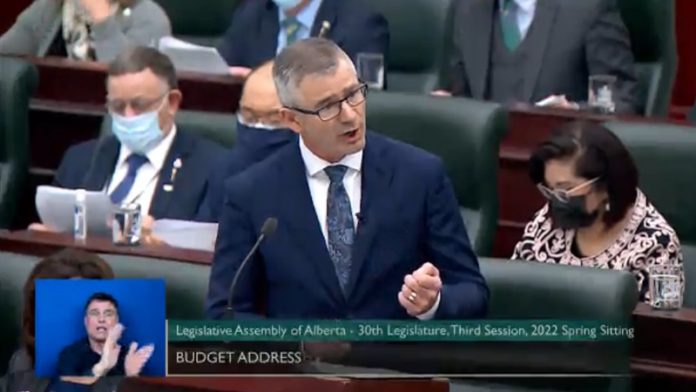Alberta’s government released its first balanced budget in eight years as surging oil prices brought a windfall of oil and gas royalties.
The province, which is the world’s fourth largest oil producer and home to Canada’s oil sands, will record a $511 million (US$398 million) surplus in its 2022 fiscal year starting April 1. That compares to a forecast deficit of $3.2 billion in the 2021 fiscal year, according to the budget released Thursday.
The surplus would be the first since the 2014 budget and marks a huge turnaround from just a year ago, when the finance ministry expected a looming deficit of $18 billion for 2021 as the COVID-19 pandemic suppressed economic activity. At that time, the Alberta government wasn’t expecting a balanced budget before 2024.
The turnaround has happened amid a surge of tax and royalty revenue driven by oil prices that on Thursday surpassed US$100 a barrel for the first time since 2014, after Russian forces invaded Ukraine. Resource revenue including oil sands royalties is expected to jump to $13.8 billion in fiscal 2022, up from a year earlier when just $2.86 billion in resource revenue was budgeted for the year ahead.
Tax revenue is projected to rise to $23 billion in fiscal 2022 from a forecast $22.1 billion in 2021, while expenses will fall to $62.1 billion in the 2022 budget year from $64.9 billion the year prior.
Alberta, the biggest foreign supplier of crude to the U.S., is budgeting for West Texas Intermediate crude, the U.S. benchmark, to average US$70 a barrel in the coming fiscal year. So far, U.S. oil has averaged more than US$86 a barrel as tensions between Russia and Ukraine worsened and energy demand surged as pandemic restrictions eased.
Other budget forecasts include:
Gross domestic product to grow 5.4 per cent in 2022, down from 5.8 per cent in 2021
Natural gas will average $3.20 per gigajoule in the 2022-2023 budget period
Taxpayer-supported outstanding debt will total $97.7 billion at the end of 2021 fiscal year and $94.7 billion at the end of the 2022 budget year
Debt servicing costs to be $2.7 billion in 2022
Upstream oil and gas investment this year will increase by more than $6 billion to surpass the pre-pandemic level of 2019
































